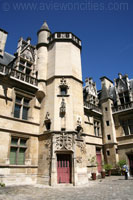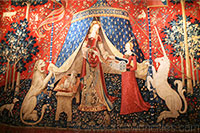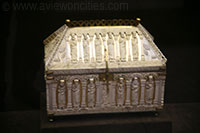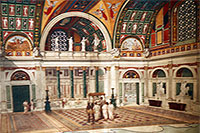The Musée de Cluny is lauded for its magnificent
collection of medieval art, displayed in a unique setting, part
Gallo-Roman ruins, part medieval mansion.
The Museum
Also known in France as the Musée National
 du Moyen Âge (National Museum of the Middle Ages), the Musée de Cluny sits in Paris's 5th arrondissement.
du Moyen Âge (National Museum of the Middle Ages), the Musée de Cluny sits in Paris's 5th arrondissement.

Musée de Cluny
The museum houses many notable medieval artifacts,
including sculptures from the 7th and 8th century, important
manuscripts, gold and ivory pieces, and many antique furnishings. The
museum also owns a fine collection of tapestries of that era, including
"The Lady and the Unicorn", a series woven in Flanders and made of wool
and silk. These are often considered among the finest works of art from
medieval Europe.
The Building
The museum is housed in building known as the Hôtel de Cluny. Not a hotel in its most
 commonly known form (i.e. a place to lodge) but rather a expansive
house, the Hôtel de Cluny was - in the early 14th century - owned by the
abbots of Cluny, who headed a powerful Benedictine order. The complex
also once included a college for religious education, but that is no
longer standing.
commonly known form (i.e. a place to lodge) but rather a expansive
house, the Hôtel de Cluny was - in the early 14th century - owned by the
abbots of Cluny, who headed a powerful Benedictine order. The complex
also once included a college for religious education, but that is no
longer standing.

The Lady and the Unicorn
The monks of Cluny owned the structure for about
100 years, after which time it was taken over by Jacques d'Amboise,
Bishop of Clermont, who used it as his residence and rebuilt it with
many Gothic and Renaissance elements. It is this remodeled hotel that is
still standing today.
In addition to the bishop, it is said that a number
of notable personalities lived in the house at one time or another,
including Mary Tudor, who was sent there after her husband Louis XII
died, so that the new king of
 France could keep an eye or her and determine whether or not she was pregnant with an heir.
France could keep an eye or her and determine whether or not she was pregnant with an heir.

Later Years
In 1793, the state assumed ownership of the Hôtel
de Cluny and it was used for several different functions. According to
the Paris Michelin Guide, the upstairs chapel - done in flamboyant
Gothic style - was once used as a dissection room by a Paris doctor.
But the collection inside the Cluny Museum began
when the art collector Alexandre du Sommerard moved in. He already owned
an impressive collection of medieval and Renaissance objects that he
brought with him to the house, and when he died in 1842, he donated them
to the state. A museum opened just a year later.
Baths of Cluny

Baths of Cluny
The museum includes some of the remains of the baths, known as the Thermes de Cluny (Baths of Cluny). The baths were built at 200 A.D., but were destroyed around 100 years later by invading barbarians.
No comments:
Post a Comment